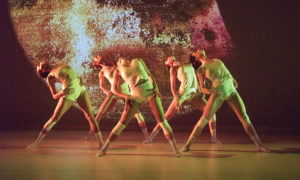Vancouver: Summer 2019 - Vancouver Ballet Society
- Home
- City Reports 2015 - 2019
- Vancouver: Summer 2019

By Kaija Pepper
The biggest news this quarter was the world premiere of Crystal Pite’s Revisor, a co-creation with Jonathon Young from Electric Company Theatre. All four performances at the Vancouver Playhouse, in February, sold out months in advance, an unheard of success in the local dance world.
Pite and Young have become a force for dance-theatre. Like their award-winning Betroffenheit, a vaudeville-styled extravaganza about traumatic stress, Revisor tackles a hard theme — the corruption of power — this time through farce.
The opening section is a magnificent showcase for the eight dancers, who power through a whirl of full-body syncing to recorded dialogue. This goes far beyond the challenges of lip-syncing — though there is that, too, when it seems as if the dancers are actually speaking. Revisor pushes the close relationship of dance and text to its limit in a comical tale of epic proportions.
Presented by Pite’s Vancouver-based company, Kidd Pivot, the work had its avant-premiere a week earlier in Banff [this issue’s cover story] and set off to tour across Canada following the Vancouver shows.
Fragile Forms, by local choreographers Delia Brett and Daelik of MACHiNENOiSY, had its own quieter power. Presented as part of PuSh International Performing Arts Festival, this site-specific work explored how bodies in motion impact our experience of a place: the Anvil Centre in nearby New Westminster.
For about an hour, two small groups of audience members followed their leader up and down stairs, into small recesses and medium-sized rooms, onstage and, finally, to the impressive 60-foot-high atrium lobby of the four-year-old Anvil Centre.
The detail of what we were led to observe was phenomenal, including reflections of the dancers in ground-floor windows that seemed to put them in the middle of traffic, an effect that would have taken a whole lot of designing and money to put onstage. That’s the beauty of site-specific work — the artists have the real world as their toolbox. Inspired by Finnish architect Juhani Pallasmaa’s work, Fragile Forms had a residency in Finland, with two dancers from Helsinki among the ensemble of 11.
Wen Wei Wang, Ballet Edmonton’s new artistic director, continues to present work through his Vancouver-based contemporary group, Wen Wei Dance. Ying Yun, at Scotiabank Dance Centre, was titled with the name of his mother, to whose passing the piece is dedicated. Also, according to the program notes, “Ying could mean hero, Yun indicates clouds.”
The abstract work is framed by Sammy Chien’s beautiful video design, which turned the backdrop into a visual art canvas, ranging from glowing electronic lines to a swirling eclipse of deep dark colours. Linda Chow costumed the five young women dancers all in white — shorts, prettily detailed tops and socks, perhaps evoking the clouds of the title.
The first section, in particular, was a lovely presentation of Wang’s by now well-known vocabulary, with its deep lunges and bold physicality. The dancers take bendy, stretched poses, pushing out their hips and chests. Their bodies squirm into shapes, but not casually; every moment is carefully choreographed.
Also at the end of February, Ballet BC premiered a piece by emerging Israeli choreographer Adi Salant, bookended by remounts of two masterworks: Jorma Elo’s 1st Flash (2003) and Crystal Pite’s Solo Echo (2012), both originally performed by Nederlands Dans Theater.
Ballet BC has danced Elo’s humorous, quirky and musically astute 1st Flash several times since giving the work its Canadian premiere in 2013. Set to two movements from Jean Sibelius’ sublime Violin Concerto in D minor, 1st Flash has the formality and sophistication needed to fill the Queen Elizabeth Theatre’s large stage and reach the upper distances of the auditorium.
The six dancers performed as if each move — both the details and the larger effect — was a matter of life and death. Elo approaches the mighty flow of orchestral sound from Sibelius, his fellow Finn, by grounding the dance in its own flow, working with the music and even illustrating it — but not slavishly, and not always.
This was a hard act to follow, and Salant is apparently new to the choreographic game. Formerly co-artistic director at Batsheva with the renowned choreographer Ohad Naharin, she also teaches Gaga (the movement form he originated) and was a dancer with the company.
Salant’s WHICH/ONE, performed by 11 Ballet BC dancers and five of the company’s emerging artists, showed Naharin’s influence in the extremes of luscious, fulsome body expression. There were also times when the performers focused on familiar modern dance gestural vocabulary, wildly shaking their hands or compulsively touching their heads. Though dramatically thin, WHICH/ONE did successfully rally the large cast to action.
Pite’s Solo Echo closed the evening with an intensely tender evocation of individuality and togetherness, two states of being that she is a master of depicting in motion.

Daria Mikhaylyuk and Stéphanie Cyr in Wen Wei Wang’s Ying Yun
Photo: Chris Randle
